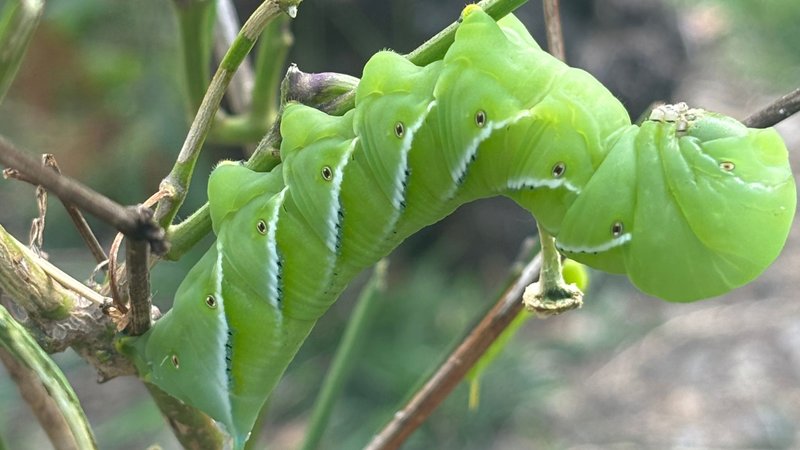
Think of it this way: if your garden was a school, hornworms are like bad students that keep failing the same grade. By rotating crops, you change the subjects being taught—making it harder for those naughty pests to stay in the same class. You might have heard of this method before, but does it really work? Let me break it down for you.
Understanding Hornworms: The Enemy in Your Garden
Hornworms are the larvae of moths, specifically the Five-spotted Hawk Moth or the Tomato Hornworm. These critters can grow up to 4 inches long, and believe me, they can put quite a dent in your plants! They love feasting on tomatoes, peppers, eggplants, and even potatoes. Seeing these green monsters munching away can be disheartening, but knowing what you’re up against is the first step to winning the battle.
Here’s the thing: hornworms can be quite clever. They often camouflage themselves with the plants they chew on, making them hard to spot. If you don’t catch them early, they can strip a plant of its foliage in just a few days. Not only are they a nuisance, but they can also significantly reduce your crop yield, which is certainly not what any gardener wants.
You might be wondering what attracts these pests to your garden in the first place. Well, they love high-nitrogen environments, which means over-fertilizing can easily attract their attention. Keeping your soil balanced and practicing proper fertilization can help reduce their chances of coming back for seconds!
The Basics of Crop Rotation
Crop rotation involves changing the types of crops you plant in a particular area each growing season. Instead of planting the same vegetables year after year, you alternate them based on their family group. For example, if you plant tomatoes one year, you may follow up with beans or corn the next. This technique has several benefits, including pest control, improved soil health, and reduced diseases.
You might be wondering how this all connects back to hornworms. Well, these pests have preferences for certain plants. By rotating your crops and not planting their favorite foods in the same spot year after year, you’re essentially cutting off their food supply. Less food means fewer hornworms—it’s as simple as that!
Moreover, different plants can enhance soil quality. Legumes, for example, add nitrogen back into the soil, while others can help improve soil structure. This means that a well-planned crop rotation can contribute to healthier plants, making them less vulnerable to infestations.
How Crop Rotation Helps Manage Hornworm Populations
When you incorporate crop rotation into your gardening routine, the benefits can be felt right away. By moving plants around, you disrupt the life cycle of pests like hornworms. They might hatch and be ready to feast, only to find that their favorite food is no longer in the same spot. This can lead to a significant reduction in their numbers over time.
Consider this: if you plant tomatoes every year in the same spot, hornworms that survive the winter will know exactly where to go for breakfast. But if you switch to a crop they don’t prefer, like beans, you’ll confuse those pests, forcing them to search for their food elsewhere. You could even think of it as a culinary surprise—they’re looking for Mexican food, but you serve up Italian instead!
Additionally, rotating crops can help introduce beneficial insects into your garden. These insects, like ladybugs and certain types of wasps, can help control pest populations naturally. With fewer hornworms munching on your plants, your garden can flourish without the need for harsh chemicals.
Planning Your Crop Rotation Schedule
Creating an effective crop rotation schedule doesn’t need to be complicated. Start by grouping your plants according to their families. Here’s a simple breakdown:
- Nightshades: tomatoes, peppers, eggplants
- Cucurbits: cucumbers, squash, melons
- Legumes: beans, peas, lentils
- Brassicas: broccoli, cabbages, cauliflower
- Root Vegetables: carrots, onions, beets
Plan to rotate your crops so that plants from the same family aren’t grown in the same place more than once every three years. This will significantly reduce hornworm populations and other pests while maintaining soil health.
You could keep a gardening journal or use planting apps to track your crop rotation. Not only will this help you remember what you planted where, but it can also serve as a tool for planning future seasons.
Complementary Pest Control Techniques
While crop rotation is a powerful strategy against hornworms, combining it with other pest control methods can enhance your results. Here are a few ideas to consider:
- Handpicking: When you spot hornworms, just grab them off your plants! This is a simple yet effective way to reduce their numbers.
- Beneficial Nematodes: These microscopic worms can be introduced to the soil to help control hornworm populations by attacking them in their larval stage.
- Companion Planting: Some plants can repel pests. For example, planting marigolds alongside vegetables can deter many insects, including hornworms.
- Natural Sprays: You can use organic pesticides, such as neem oil, to keep pest populations in check without harming beneficial insects.
Using these techniques in conjunction with crop rotation can create a more holistic approach to pest management, leading to a healthier and more productive garden.
Challenges of Crop Rotation You Should Know
Of course, no good plan is without its challenges. Crop rotation can be tricky, especially if you have a small garden or limited space. You might find yourself grappling with uneven growth or even forget to follow your rotation schedule.
Another consideration is plant compatibility. Some plants don’t grow well near each other, known as “allelopathy.” For instance, tomatoes shouldn’t be planted near potatoes due to the increased risk of diseases. Research which crops can thrive together, and adapt your rotation accordingly.
Lastly, depending on your climate, some crops may not be viable for certain times of the year, which could limit your rotation options. You can combat this by choosing region-specific plants that can thrive in your specific growing conditions.
Incorporating crop rotation into your gardening strategy can make a world of difference, especially when it comes to managing hornworms. By changing the crops you plant each season, you disrupt the life cycles of these pesky pests, making it harder for them to thrive in your garden. Plus, you’re helping maintain soil health and supporting a diverse ecosystem that can naturally manage pests.
So next time you’re planning your garden, think about how crop rotation can be your secret weapon against hornworms. It’s like giving your plants a fresh start every season, creating a more enjoyable gardening experience for you. Remember, a little planning goes a long way, and soon enough, you’ll be harvesting healthy, hornworm-free vegetables to enjoy!

